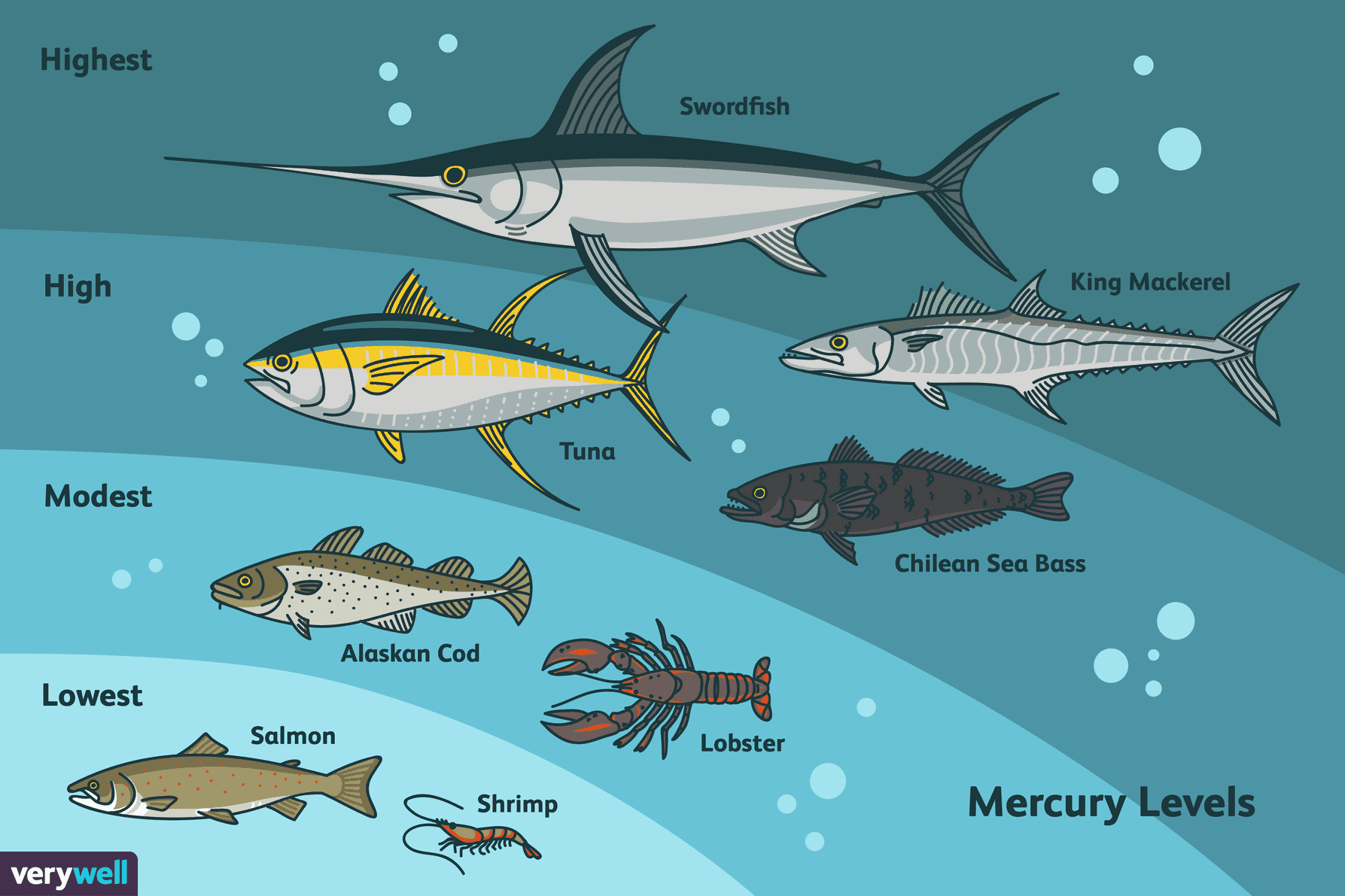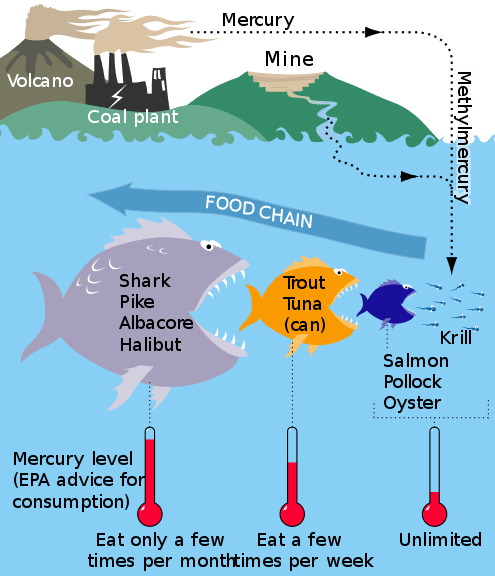I know Ray Peat has talked about cod, sole, shellfish as safe. What are other safe fishes (low fat, low mercury) we can consume?
Here's info on mercury levels in fish

Which Fish Have the Most Mercury?
Large fish have more mercury for the simple reason that big fish usually live longer. They have more time to build up higher levels of mercury in their bodies. See the lists below for general mercury levels of many common types of fish and how much of each type to eat (according to the National Resource Defense Council).5
Fish and Shellfish Lowest in Mercury
Eat two to three servings a week of the following fish (pregnant women and small children should not eat more than 12 ounces or two servings):
Fish With Modest Amounts of Mercury
Eat six servings or fewer per month (pregnant women and small children should avoid these):
Fish High in Mercury
Eat three servings or less per month (pregnant women and small children should avoid these):
Fish Highest in Mercury
The FDA lists these choices to avoid eating:

Mercury in fish - Wikipedia
Info on low-fat fish:
What Types of Fish Are Low in Fat?
Jessica Bruso
Fish are one of the best sources of the essential omega-3 fats eicosapentaenoic acid, or EPA, and docosahexaenoic acid, or DHA. These omega-3 fats may lower your risk for heart disease, which is why the American Heart Association recommends you eat fish at least twice a week. Low-fat fish make it easier to stay within the recommended fat limit for the day of no more than 35 percent of your calories, but may also be lower in essential omega-3 fats than higher-fat fish.
Very Low-fat Fish
The fish that provide the least amount of fat, with less than 2 grams of fat per 3-ounces of cooked fish, include orange roughy, tuna, pollock, mahi mahi, cod, hake, haddock, sole and flounder. Tuna and cod are especially good options if you are trying to maximize your protein intake, since they are among the fish highest in protein per calorie. Choose tuna or pollock if you are trying to maximize your omega-3 fats while minimizing total fat consumption.
Low-fat Fish
Tilapia, chum and pink salmon, ocean perch, halibut and Pacific rockfish are also low in fat, with less than 5 grams of fat per 3 ounces of cooked fish. Of these options, salmon is significantly higher in omega-3 fats, providing 900 to 1,825 milligrams per serving depending on the type you choose. This is more than the recommended amount of at least 500 milligrams per day.
Additional Low-fat Seafood Options
While not technically fish, shrimp, scallops, crab, lobsters and clams all contain less than 2 grams of fat per 3-ounce serving and oysters and mussels provide less than 5 grams per serving. Oysters, crab and scallops all provide at least 300 milligrams of omega-3 fats per serving, making them among the better low-fat seafood choices.
Other Health Considerations
When choosing fish or seafood, fat content isn't the only important factor. Some types of seafood tend to contain higher levels of mercury than others, making it important to limit these in your diet. Orange roughy, big eye and ahi tuna are among the low-fat fish highest in mercury, so avoid these. Yellow fin and canned albacore tuna are also high in mercury, so choose chunk light tuna or skipjack tuna instead. The fish both lowest in fat and lowest in mercury include flounder, hake and haddock. Salmon, tilapia, ocean perch, shrimp, scallops, crab and clams are also good low-fat and low-mercury options.
Sources of Low-Fat Protein | Livestrong.com
Here's info on mercury levels in fish

Which Fish Have the Most Mercury?
Large fish have more mercury for the simple reason that big fish usually live longer. They have more time to build up higher levels of mercury in their bodies. See the lists below for general mercury levels of many common types of fish and how much of each type to eat (according to the National Resource Defense Council).5
Fish and Shellfish Lowest in Mercury
Eat two to three servings a week of the following fish (pregnant women and small children should not eat more than 12 ounces or two servings):
- Anchovies
- Catfish
- Clam
- Crab
- Crawfish
- Croaker (Atlantic)
- Flounder
- Haddock
- Hake
- Herring
- Mackerel (North Atlantic, Chub)
- Mullet
- Oyster
- Perch (The FDA lists this on the low list, but the NDRC lists it as moderate or high)
- Pollock
- Salmon
- Sardine
- Scallop
- Shrimp
- Sole
- Squid
- Tilapia
- Trout
- Whitefish
Fish With Modest Amounts of Mercury
Eat six servings or fewer per month (pregnant women and small children should avoid these):
- Bass (Saltwater, Striped, Black)
- Buffalofish
- Carp
- Cod (Alaskan)
- Halibut
- Lobster
- Mahi Mahi
- Monkfish
- Perch (freshwater)
- Snapper
- Skate
- Tilefish (Atlantic)
- Tuna (canned chunk light)
Fish High in Mercury
Eat three servings or less per month (pregnant women and small children should avoid these):
- Bluefish
- Grouper
- Sea Bass (Chilean)
- Mackerel (Spanish, Gulf)
- Croaker (White, Pacific)
- Sablefish
- Perch (ocean)
- Tuna (canned albacore, yellowfin)
Fish Highest in Mercury
The FDA lists these choices to avoid eating:
- King mackerel
- Marlin
- Orange Roughy
- Shark
- Swordfish
- Tilefish (from the Gulf of Mexico)
- Tuna (Bigeye, Ahi)
- Bluefish and grouper: The National Resources Defense Council adds these to the list of those to avoid.

Mercury in fish - Wikipedia
Info on low-fat fish:
What Types of Fish Are Low in Fat?
Jessica Bruso
Fish are one of the best sources of the essential omega-3 fats eicosapentaenoic acid, or EPA, and docosahexaenoic acid, or DHA. These omega-3 fats may lower your risk for heart disease, which is why the American Heart Association recommends you eat fish at least twice a week. Low-fat fish make it easier to stay within the recommended fat limit for the day of no more than 35 percent of your calories, but may also be lower in essential omega-3 fats than higher-fat fish.
Very Low-fat Fish
The fish that provide the least amount of fat, with less than 2 grams of fat per 3-ounces of cooked fish, include orange roughy, tuna, pollock, mahi mahi, cod, hake, haddock, sole and flounder. Tuna and cod are especially good options if you are trying to maximize your protein intake, since they are among the fish highest in protein per calorie. Choose tuna or pollock if you are trying to maximize your omega-3 fats while minimizing total fat consumption.
Low-fat Fish
Tilapia, chum and pink salmon, ocean perch, halibut and Pacific rockfish are also low in fat, with less than 5 grams of fat per 3 ounces of cooked fish. Of these options, salmon is significantly higher in omega-3 fats, providing 900 to 1,825 milligrams per serving depending on the type you choose. This is more than the recommended amount of at least 500 milligrams per day.
Additional Low-fat Seafood Options
While not technically fish, shrimp, scallops, crab, lobsters and clams all contain less than 2 grams of fat per 3-ounce serving and oysters and mussels provide less than 5 grams per serving. Oysters, crab and scallops all provide at least 300 milligrams of omega-3 fats per serving, making them among the better low-fat seafood choices.
Other Health Considerations
When choosing fish or seafood, fat content isn't the only important factor. Some types of seafood tend to contain higher levels of mercury than others, making it important to limit these in your diet. Orange roughy, big eye and ahi tuna are among the low-fat fish highest in mercury, so avoid these. Yellow fin and canned albacore tuna are also high in mercury, so choose chunk light tuna or skipjack tuna instead. The fish both lowest in fat and lowest in mercury include flounder, hake and haddock. Salmon, tilapia, ocean perch, shrimp, scallops, crab and clams are also good low-fat and low-mercury options.
Sources of Low-Fat Protein | Livestrong.com
Last edited:
